The engraving pattern is based on the engraving pattern that was used on the 1928 Slingerland Gold Plated Artist Models
Read more1995 SLINGERLAND 6.5 x 12 BRASS/ENGRAVED #1 of 5

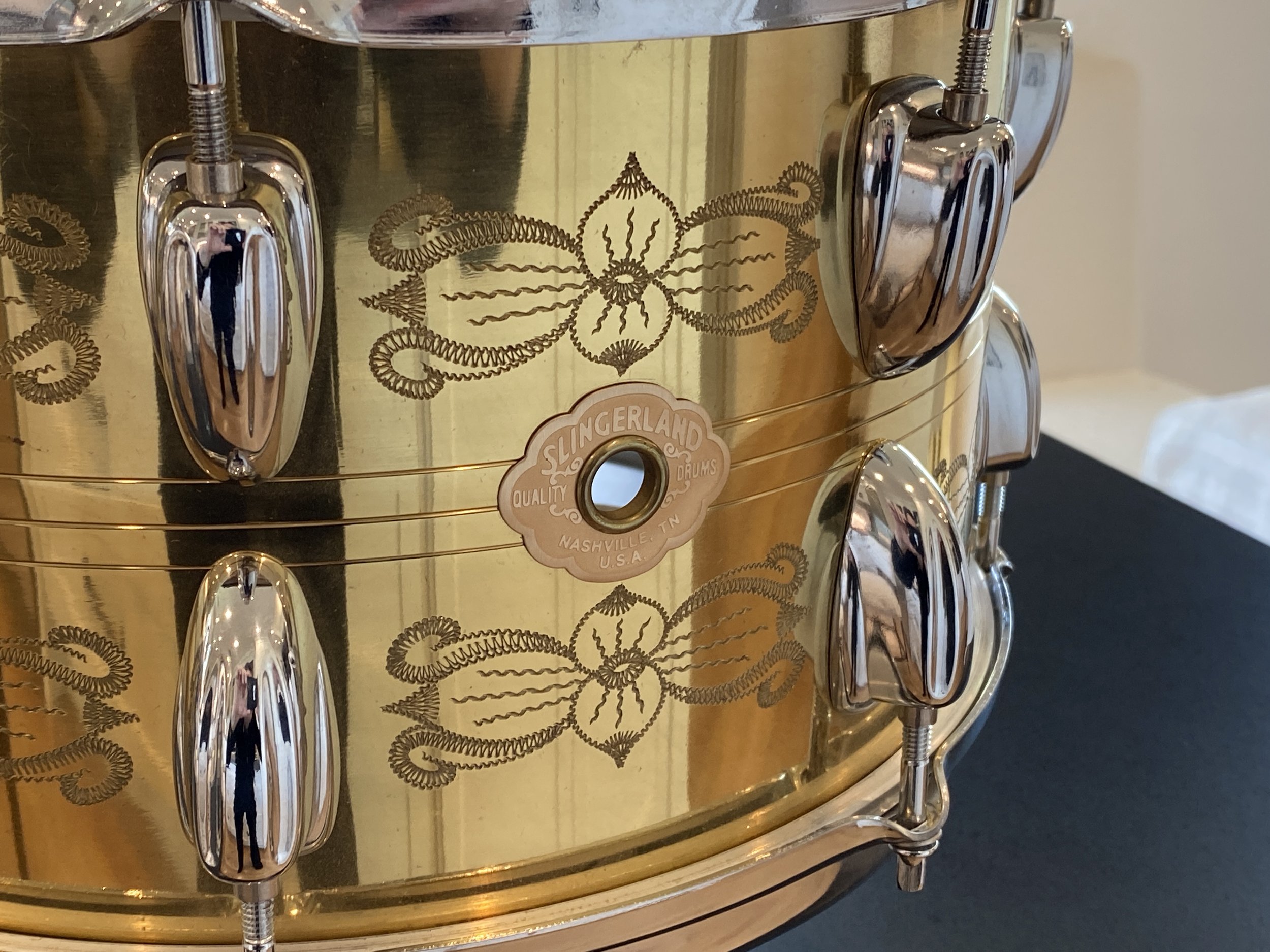
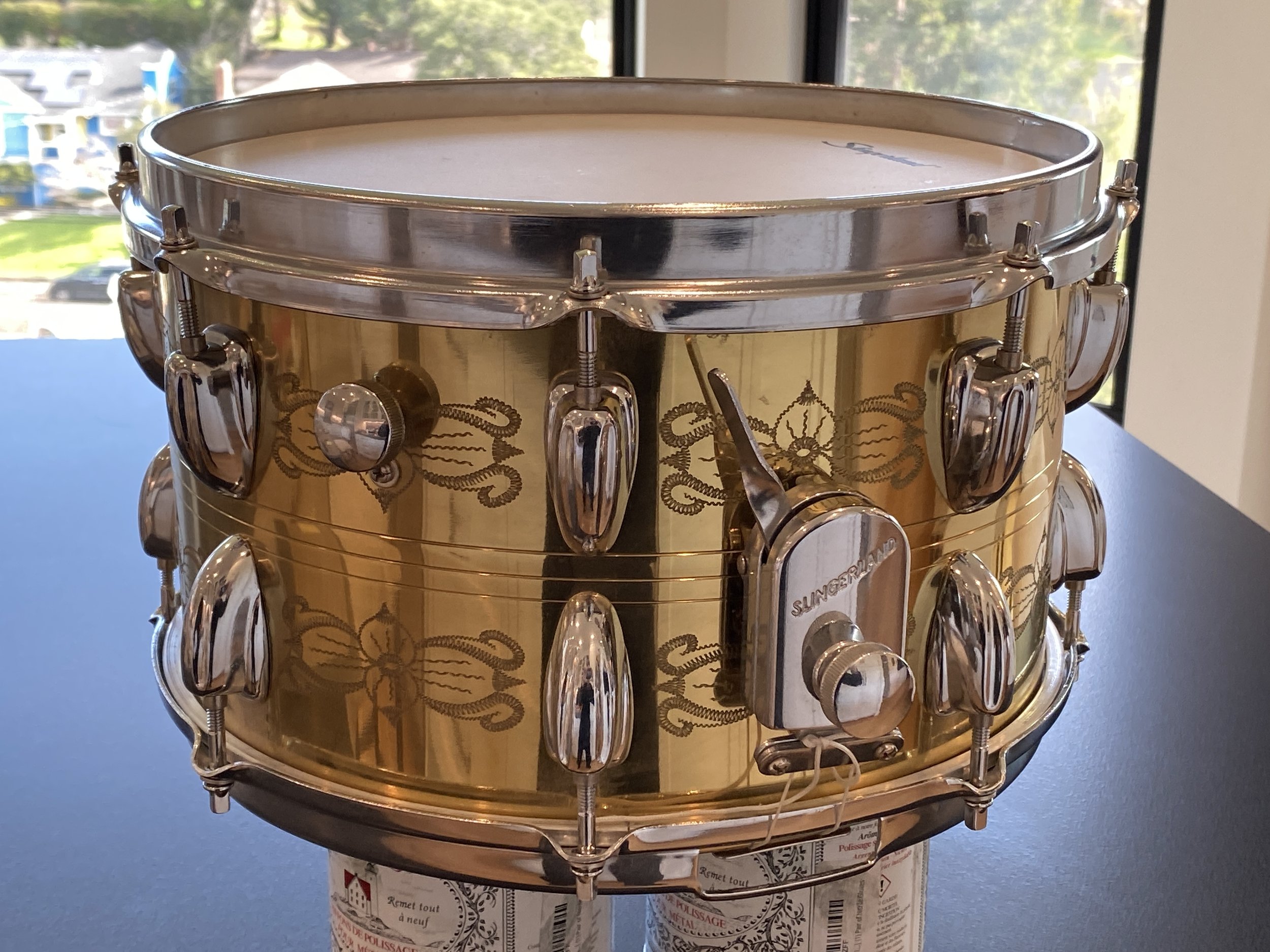
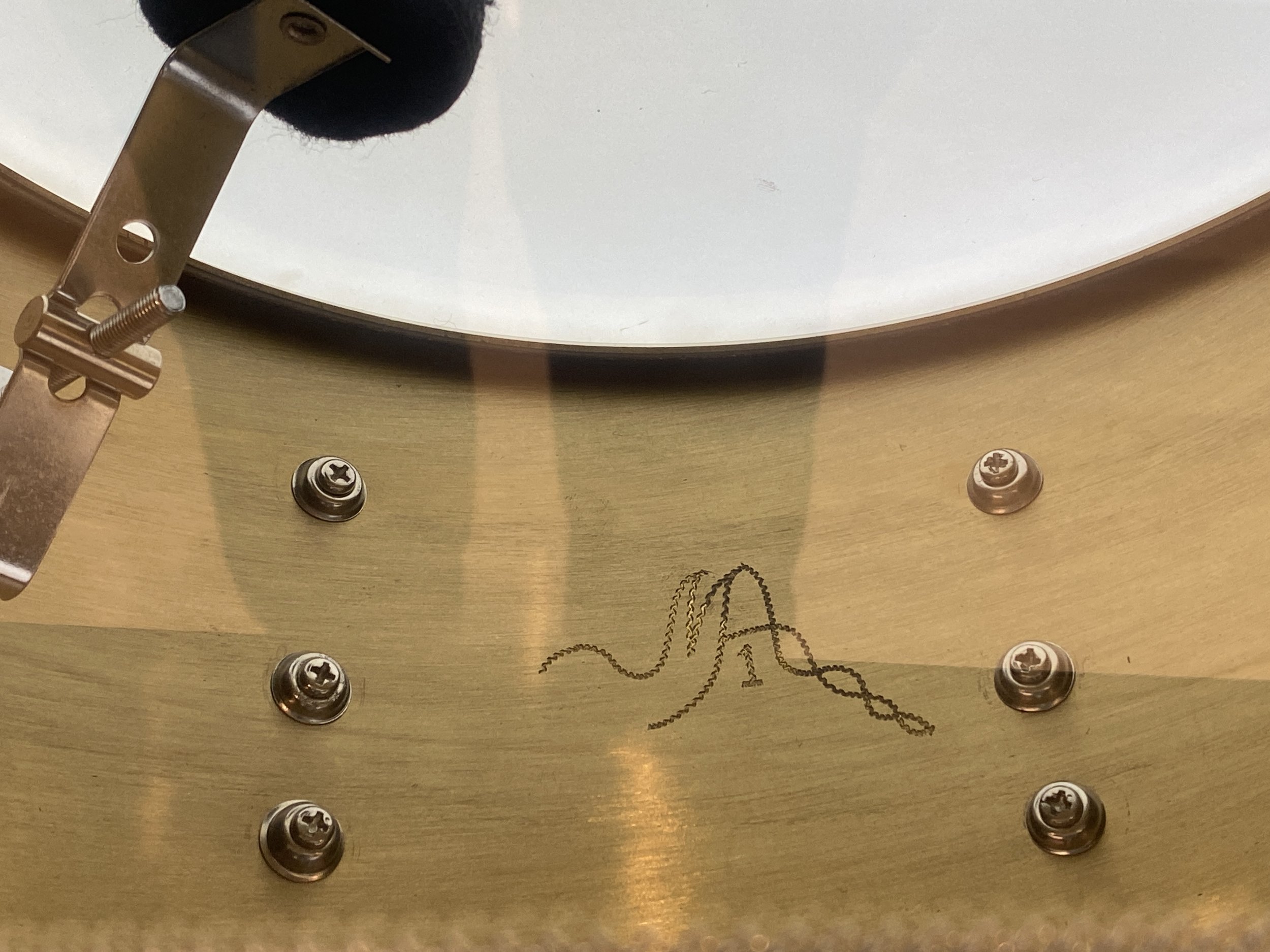
Drummer community & drum marketplace
The first vintage & Custom Drum Magazine, since 1988

The engraving pattern is based on the engraving pattern that was used on the 1928 Slingerland Gold Plated Artist Models
Read moreIn the beginning of Japan’s rise of drum making in the early 60’s all of the major manufacturers in one form or another used Slingerland’s styling in the making of their own drums. Some of these companies were simply inspired and a few crossed the line into infringement, either way Slingerland just let it happen
Read moreI got this drum from my good friend and fellow collector/drum historian
Harry Cangany. Harry was thinning out his collection and we struck a deal.
All my items I have listed on DrumSellers.com have been repriced with “or best offer”. This includes all snare drums, drum sets, cymbals of mine and of those consigned to me by Steve Johnson, Tom Boyle, John Dittrich, and Jason Cooper. Well over 300 cymbals, 50 snare drums and several drum sets. This
Read moreThese drums are without a doubt the cleanest most reliable "Players grade" Bomber set of unborn together drums out there. Every screw nut bolt and bits as well as interior moisturized and protected shells has been addressed. All of the drums will have medium modern batter heads and thinner reso heads that are a combination of Aquarian vintage and remo ambassadors.. The BD has an Aquarian SKIII batter head and the Fiberskyn Reso head. The snare has been modified for maximum performance with in its original design. Calfskin could be an option for a reflected price and of course results are not guaranteed. (SOLD)
Read moreI saw this one at a NAMM Show in the late 1990s, maybe early 2000s. At that time Leedy was trying for some type of comeback. I got the drum from Sam Bacco who at the time was associated with Leedy. He told me that he located one long-lost piece of this material from Slingerland and there was enough material left over to make a Leedy Broadway Standard snare drum. Sam told me that the finish was made with melted guitar picks (you can see some un-melted guitar picks in the finish).
Read moreJim has a deep family history that revolves around Slingerland drums dating back to when Slingerland was a guitar company. His great uncles and father were long time employees of the company running the woodshop, and Jim worked there in his high school years during the night shifts.
Read moreIf you have ever found yourself looking at an old vintage drum and wondering, “What year was this made?”, or “When did they first use this type of snare strainer?”, or “What’s the name of this unusual finish?”, then this vintage drum guide may be of interest to you. The purpose of this guide is to help identify the various types, models, and features of vintage drums during the years 1923 to 1965. I consider this period to be the “golden age” of American drum manufacturing. This
Read moreBy Mike Curotto and Joseph Mekler
A lot of you fellow collectors know how excited I get when an ultra-rare snare drum comes my way but in this case I was more astonished at the restoration of this drum than I was at being able to add this drum to my collection. _ Mike Curotto.
Read moreI recently had an idea after looking at some old black and white vintage drummer photos. What I wanted to do was set up a photo shoot with one of my vintage kits and pose like the old drummers did in those cool promotional photos.
Read moreThe floor tom is the real story with this set. I don't know the history concerning this set first hand, so I am going to put forth a guess as to why the floor tom is a matching Slingerland made Leedy drum. We all know that Bud Slingerland bought Leedy from Conn at the same time William F. Ludwig bought the Ludwig brand from Conn. This was in the mid 1950s. I believe someone had purchased this Leedy and Ludwig set in 1954 as a three piece set. That was not uncommon at all in those days. He later went back to the music store, maybe in 1956 and asked if he could purchase a matching floor tom for his set. By this time Slingerland was able to fill the order for the store to sell to the customer.
Read moreI'm pretty sure I now have one of the last Slingerland kits ever made, and it's a good one, and I didn't have to pay Slingerland's ridiculous exorbitant prices for it.
Read moreSlingerland drums are very cool drums. The set I am showing you this month was owned by the original owner since they were brand new, and I fell in love with this five piece set the first time I saw them.
Read moreHi all,
Here's another one cleaned up and entered into the collection. I got this snare drum at the 2011 Chicago Show from our good friend and fellow collector, Mark Cooper of Cooper's Vintage Drums.
1934-35 SLINGERLAND 6.5 x 14 SPARKLING GREEN/ARTGOLD *BROADCASTER MODEL
*The Broadcaster Model was very short-lived so for those of you that may not be familiar with this model here is a short history and background data regarding the Slingerland Broadcaster Model. The following is from Rob Cook's Slingerland Book (first edition): "The Broadcaster was evidently a forerunner of the Radio King, the strainer is a very early Radio King style strainer and the lugs do not have inserts. (The tension rods thread directly into the lugs.) The muffler was the single-pad style Harold R. Dodd muffler." Thanks again to Rob Cook. I have also read that Slingerland was legally forced to discontinue using the word "Broadcaster" (with a "c") as the Fred Gretsch Co. had been using the name "Broadkaster" (with a "k") on their drums way before Slingerland and therefore the court ruled in favor of Gretsch that Slingerland's Broadcaster was too close sounding/looking to Gretsch's Broadkaster.
The Shell: The Sparkling Green wrap was in pretty good shape with very few of those black "cancer" spots that usually show up on these older Green Sparkle drums. I was able to get a few layers of age off of the wrap with my Maguire's cleaning/polishing regime and the Sparkling Green finish came back to life. The solid maple shell interior was also in good shape and only needed a very light cleaning. The cloud badge was tight and weathered the last 75+ years pretty well.
The Hardware: I'll call it Slingerland Artgold but the hardware finish on this snare drum really resembles the Ludwig & Ludwig Classic Gold (brass plating with gold lacquer) finish that L&L used on their early-mid 1930s Black Beauties. There was a lot of Artgold present but an equal amount of age and tarnish. I haven't figured out how to duplicate the Classic Gold finish yet so the decision was to leave the hardware as is and just do a simple cleaning with a light coat of gold lacquer to seal everything to prevent any further tarnishing. The 16 tension rods were not correct so I went to my stash and found the correct tension rods but these had to be brass plated, antiqued and lacquered. Thanks again to Les and Brian Hadnagy of Avenue Plating for the brass plating and antiquing. The threaded snare gates have the letter "A" stamped on the inside (not seen) part of the rim and gates. This is called a "manufacturer's cartouche", thanks to Slingerland expert Dr. Carl Wenk for that information. I'd love to know if those type of markings are under the riveted snare gates, feel free to send photos. The Slingerland Broadcaster engraving on the top rim is pretty faint but it is there. All in all, the "carpet matches the curtains" pretty well on this drum.
Of-the-era calf heads and extension wires rounded out this cleaning/restoration.
Enjoy!
I really like Leedy drums. I know some of you share my passion for these fine American made drums. I just love the history of this company, and besides, the drums are high quality and beautiful. When I was a young boy there was a sign artist that lived next door to us. He painted signs for businesses and such, and he was a very good painter. On day I went over to his shop and there was a drum head he was painting for a local band. They were called The Wild Cherries. I remember the look of the letters on the head and what stuck out the most was the Leedy logo on the head. I had seen the Ludwig logo on Ringo's drum head and I was not as dumb as some people to think it was part of the band's name. I had never heard of Leedy drums and so I guess I was dumb at first to think the band's name was Leedy the Wild Cherries. I soon started learning information about Leedy drums from another drummer who told me they were the same as Ludwigs. That information wasn't exactly right even though Ludwig and Leedy were owned by the same company for many years, and Leedy and Ludwig were even combined for a few years in the early 1950s. Then I had a friend who had a set similar to the set I'm featuring from my collection this month. He told me Leedy was not just like Ludwigs they were just like Slingerland drums. He was also somewhat right, because Slingerland bought Leedy from Conn in the late 50s and basically made what some people call "Slingerleedys". This drum set from my collection is a Slingerland built Leedy set from the early 1960s.
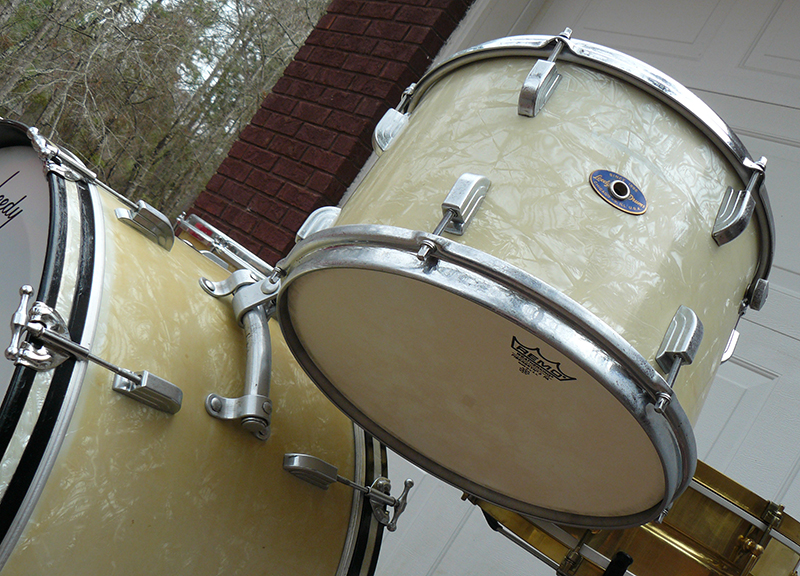
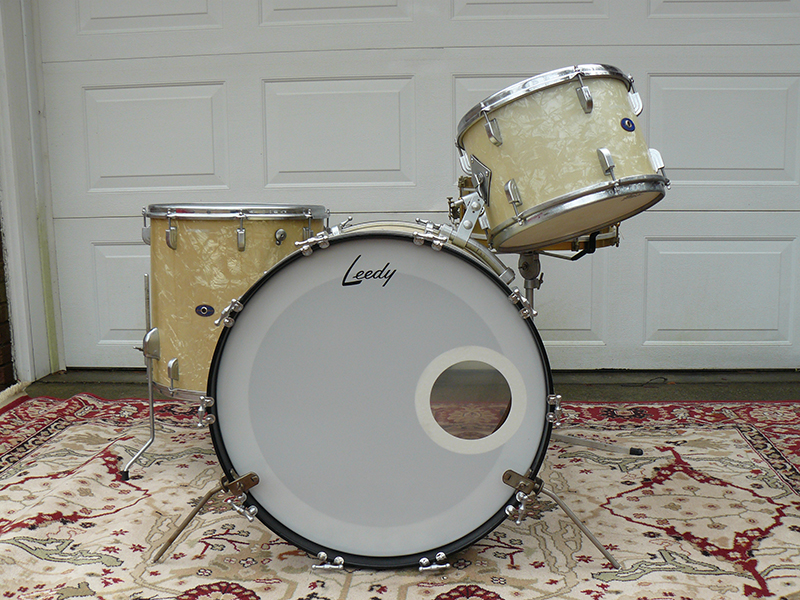
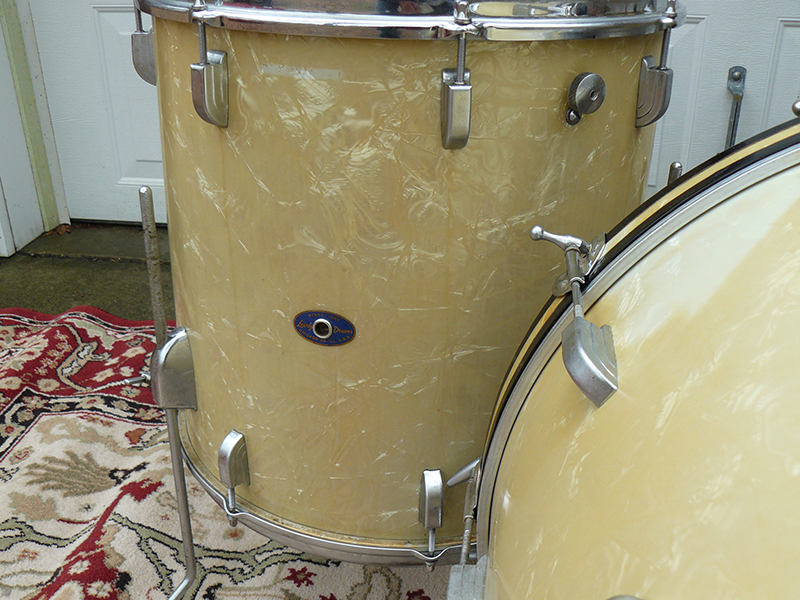

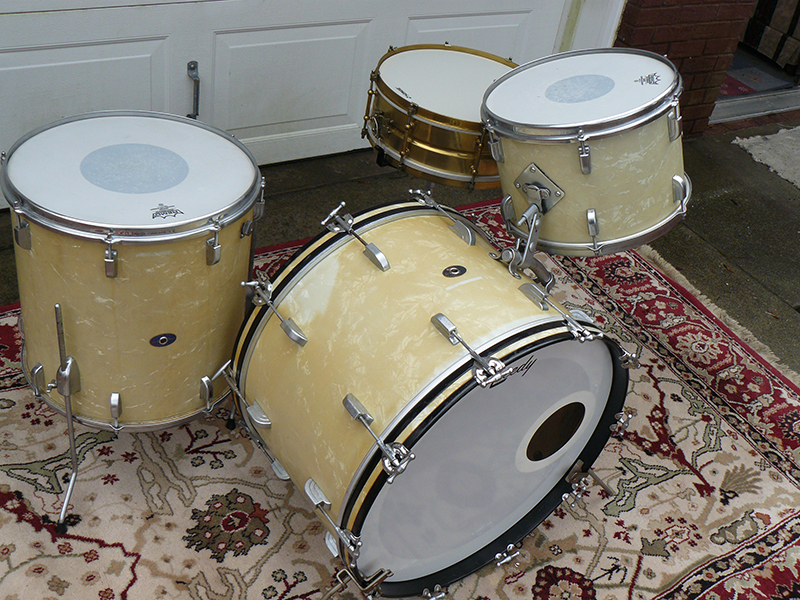

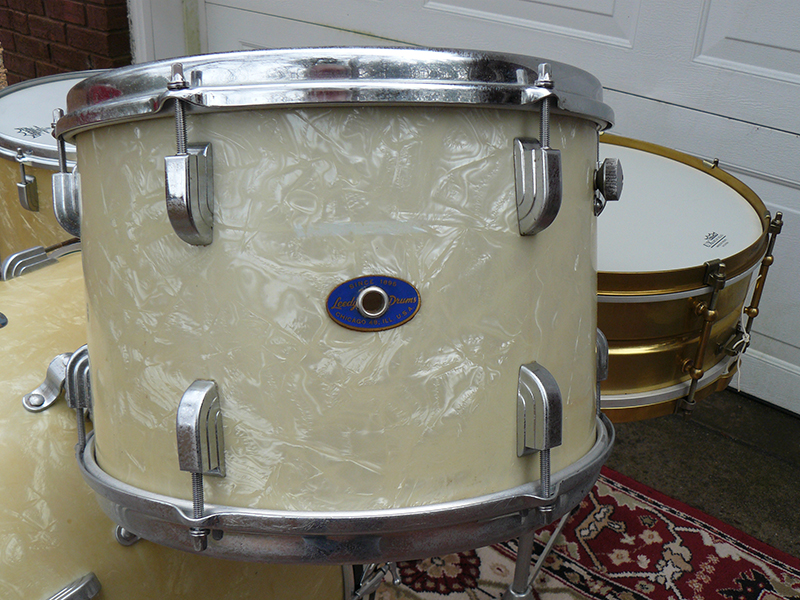
Leedy drums from this era (1956-1965) are very similar in every way to Slingerland drums with the exception of the lugs and badges. This set is a 22", 16", 13" set in standard depths. The lugs are Beavertail Leedy Lugs. You will hear the expression "Art Decco Design" when referring to these sleek modern looking lugs. The blue oval Leedy badges have Chicago 48, ILL. USA on them. This will date them 1960's. The first Leedy badge Slingerland made was a brass oval that dates drums mid 50s. The first blue oval badge '57-'58 didn't have the 48 after Chicago. The rims are "Stick Savers just like Slingerland drums. The Finish is yellowed white marine pearl. The set looks almost butterscotch. The yellowing is not consistent over the whole set. Something interesting to notice in the photos are the unfaded areas on the kick drum. The set had a cloth muffler across the batter head with excess cloth covering an area on the shell. Where the cloth shaded the shell the finish is still white. There is another white area where the front calf head was not tensioned equally. The place where the head covered the shell is still gleaming white. There was also a small sticker on the bass drum shell by the badge, and on the floor tom shell that covered a small spot. If the drums had been kept covered by a sheet when not in use they would probably be a lot whiter than they are now after 55 years. Any way, I still love that vintage "vibe" these drums have. They are beautiful to me.
I always share my adventures in collecting, because it is a lot of fun and exciting to score a great drum set. I buy some drums on E-Bay and I am not at all knocking that method of acquiring vintage drums, although It is like fishing in a barrel. It's more fun, and you really feel like you have scored when you find drums at good prices from owners or unlikely places. I realize that's more difficult now and it's becoming more difficult all the time. These drums were owned by my great friend Butch Braddy. I've told you before that he has helped me get a lot of drums over the years. He is the sales manager of the drum department at a large music store in a local city. He gets the opportunity to pass on or buy a lot of great vintage drums. I am so glad he's my friend. If he is letting something go or thinning his collection, I get a call. I try to keep some cash ready for just such an emergency. He called me recently to tell me about this Leedy set that he was parting with. I was there to lift his burden as soon as I could get to him. Thanks, Butch for this great set. Until next time, always peek into those dumpsters. You never know when someone has tossed out a Leedy Black Elite snare drum.
Hi All,
A few years ago I was contacted by drummer/educator Ed Soph who wanted some information about this drum. I told him what I knew and after a few months I was able to purchase the drum from Ed. Over the years I have discovered three versions of the Slingerland DuAll mechanism: 1. A center post very similar to if not a direct copy of the Super-Ludwig center post (usually equipped with a Tone Flange). 2. An interior “pulley” type mechanism instead of a center post (no Tone Flange). 3. No center post and no “pulley” mechanism (no Tone Flange). This snare drum has the “pulley” mechanism
The Shell: Green Sparkle from the 1930s is notorious for having black “cancer” spots. Fortunately this drum is cancer free. The finish had the normal years of accumulated schmutz but everything cleaned up and polished up nicely. The interior of the solid maple shell was very clean with no re-ring separation other than a 2” section, no big deal. The shell has normal bearing edges top (no Tone Flange) and bottom . The cloud badge is very clean with a tight grommet. Lastly, a nice factory pre-assembly artifact was found on the interior of the shell...”Nickle DuAll”.
The Hardware: The nickel hardware was in great shape and was very easy to clean and polish. There were a few errant tension rods but I had the era-correct replacements in my parts stash.
The internal DuAll “pulley” mechanism is clean, well built and looks kind of artsy. The mechanism is smooth, works well but is not as solid as the center pole version that brought on the patent lawsuit by Ludwig & Ludwig. I’ve included interior and exterior photos of this version of the DuAll mechanism. The reader will clearly see the similarities to the already patented L & L Super-Ludwig mechanism of the same era. The manufacturer’s cartouche markings on the snare gates are “L” and “LL”.
The Slingerland Artist DuAll Model was only in production for approximately two years and due to this very limited production run Slingerland DuAlls are extremely rare. As far as my snare drum collection goes, my un-scientific guesstimate based on the number of Slingerland DuAlls I own vs. the number of L & L Super-Ludwigs I own is about 15:1 meaning for every DuAll I own there are 15 Super-Ludwigs that I own. If we look at the more realistic bigger picture out there in the collecting world my guestimate is more like 100:1. That’s just my very un-scientific observation. As always, feel free to weigh-in on the subject as I look forward to your comments and added information.
A nice Frank’s Drum Shop calf batter head, Slingerland slunk head and the original snares rounded out this cleaning/restoration.
Enjoy! Mike Curotto
A very brief history for those that may not know the history of the Ludwig Super vs. Slingerland DuAll battle: Ludwig & Ludwig had the patent (1924) for their parallel (Super-Ludwig) mechanism. Along comes Slingerland with their version of a parallel mechanism that they called the DuAll model. Ludwig felt that Slingerland’s DuAll mechanism was infringing on their Super-Ludwig mechanism so they sued Slingerland and won. The court ordered Slingerland to discontinue their DuAll model and I seem to remember reading that Slingerland had to pay L & L the money that was made on their sales of the DuAll models. DuAlls were in production for less than two years so these snare drums are extremely rare.
Read moreI was scrolling through a vintage drummer Facebook group one day, and I came across a post from Joe Ciucci. Rather, I came across an open-mouth drool worthy video of his 1940 restored Slingerland Radio Kings…. Joe was just the guy attached to the post! I sent a message to Joe, and we struck up a conversation. Joe turned out to be as nice as his drums, and I offered to showcase the drums in Not So Modern Drummer. He took me up on the offer, and here we are today. Joe was instrumental in setting up our Nashville Drum Show trip to ATL Drum Collective, and if you came to the Nashville show, you couldn't have missed the Radio Kings in the vintage drum museum.
Read more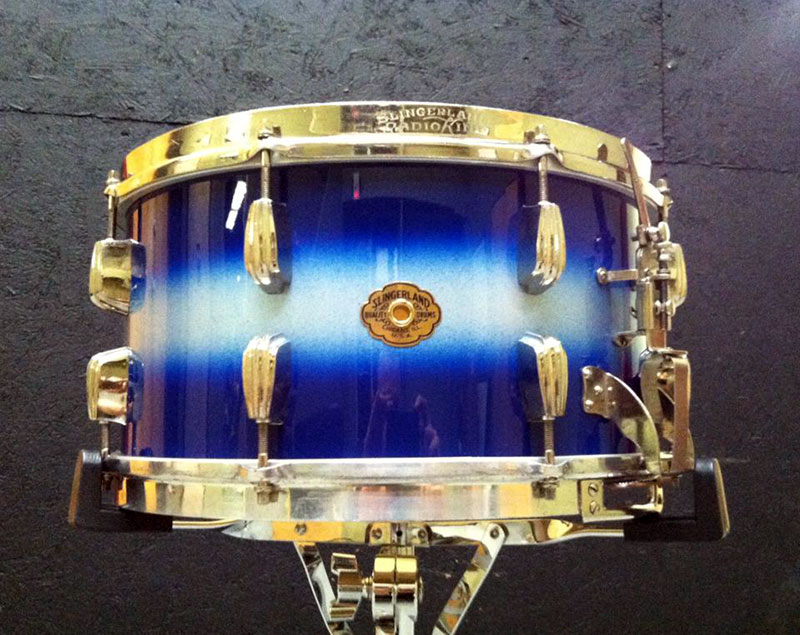
We found Joe Ciucci on Facebook a few months ago sharing pictures of his grandfather's one-owner 1940s Slingerland Radio Kings. These drums were masterfully restored by ATL Drum Collective in Atlanta, GA. We're going to run a feature article and interview with Joe in the coming months, stay tuned for more information and history, pictures of the full kit, and audio/video too!

David Klockau sends us this great collection... "[He's got] a silver 60's Ludwig Symphonic model; an early 60's Rogers Luxor; in red sparkle; (sorry, brass tube lugs are incorrect), a late 40's Slingerland Radio King in white pearl, and a 60's Gretsch Max Roach model in blue sparkle. The [photo below] has all of the above, except the Ludwig."
"Red, White, and Blue: An American Drum Legacy."
---
Thanks David! Do you have something to share? We'd love to see it! Send pictures and information to submissions@notsomoderndrummer.com.